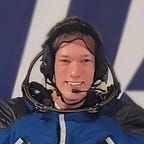Did The James Webb Space Telescope Disprove The Big Bang Theory? — Josh Habka
The JWST data suggests galaxies are formed faster than we thought, but it does not mean that they necessarily contain elements that predate the Big Bang, or that our universe is not expanding.
- JWST’s Contribution to Understanding:
- Despite viral claims, the James Webb Space Telescope (JWST) did not disprove the Big Bang theory.
- Early findings from JWST, while significant, do not challenge the fundamental concept of the Big Bang.
2. Discoveries and Initial Data:
- JWST’s initial observations include detecting some of the earliest galaxies, suggesting rapid galaxy formation after the Big Bang.
- While these findings may prompt revisions in galaxy formation theories, they do not invalidate the Big Bang.
3. Galaxy Formation Observations:
- Observations of large, well-formed galaxies in the early universe raise questions about current theories of galaxy assembly.
- However, these observations do not serve to refute the Big Bang theory but rather prompt further exploration and potential revisions.
4. Redshift and Image Quality:
- JWST’s ability to capture redshifted light enables better imaging of distant galaxies compared to previous telescopes.
- Recent images from JWST reveal the surprising massiveness and structure of the early universe, challenging long-held beliefs.
JWST did not invalidate the big bang, although a paper on a pseudo-scientific theory went viral in August, which distorted quotes by astrophysicists in order to build the false narrative that the big bang did not occur. The August quote by an astrophysicist. Although JWST has only been conducting scientific operations for a few months, it has made some signature discoveries, including detecting what may be some of the first galaxies ever seen, existing only 200 million years after the Big Bang. While The James Webb space telescope cannot tell us anything about that happened before the Big Bang event, nor has it cast any doubts about whether the universe expanded, it can tell us if the early galaxies were formed compatible with a consistent model, particularly with a hypothesis about dark matter. The first results from The James Webb Space Telescope appear to suggest that large, bright galaxies were already formed in the first 250 million years after the Big Bang.
The JWST data suggests galaxies are formed faster than we thought, but it does not mean that they necessarily contain elements that predate the Big Bang, or that our universe is not expanding. The preliminary first data from the Webb telescope seems to suggest larger galaxies in earlier times, a challenge to a consistent model. Lerner seems to be suggesting that the far-flung galaxies seen in the images are older than Big Bang theories allow, as they seem to resemble fully formed galaxies. While the stunning images taken by JWST might surprise scientists with the way it could alter theories of galaxies formation, it does not negate the Big Bang theory at all.
While it is premature to throw out a theory that is so strongly supported by data like that from the Big Bang, observations of large, well-formed galaxies this early really does call for some reaction from the astronomical community. This has nothing to do with rebutting the Big Bang; rather, it might prompt a revision in our theories about how matter in the universe is assembled into galaxies. In that respect, there is a piece starting to circulate on social media saying the James Webb Space Telescope has refuted the Big Bang Theory. The Eric Lerner article used some early research from the James Webb Space Telescope in an effort to dismiss the predominant theories.
Light from very distant galaxies is redshifted in that part of the spectrum, and therefore James Webb Space Telescope must have been able to produce better images of very distant galaxies. In fact, a comparison on-line shows that Webb’s Deep Field images are still better than Hubble’s spectacular images. Creationists have long noted that the Big Bang suffered from a ripe distant galaxies problem. According to The Washington Post, images taken by JWST revealed that the early Universe was surprisingly massive, not to mention well-balanced and well-formed — a discovery that challenges, and likely will rewrite, long-held beliefs about the origins of our Universe.
